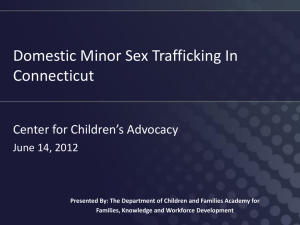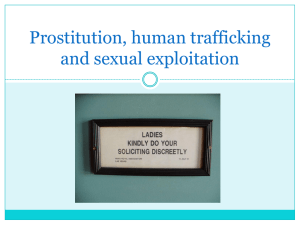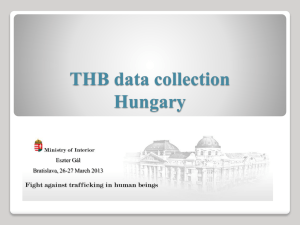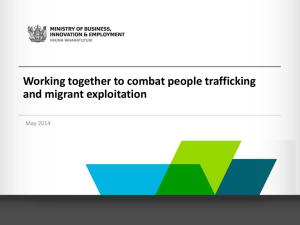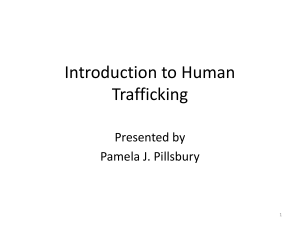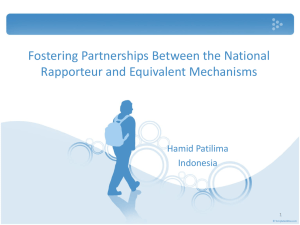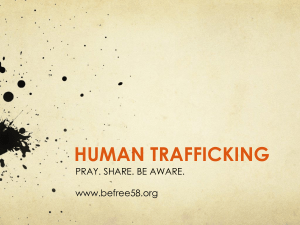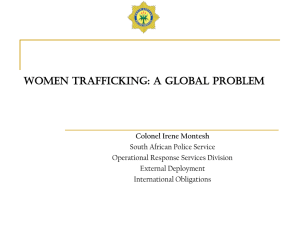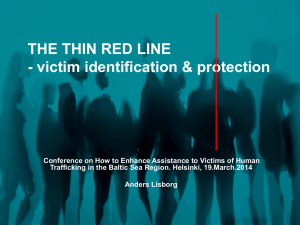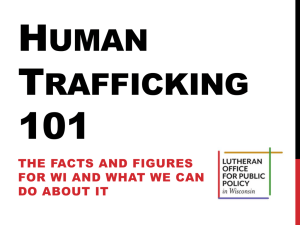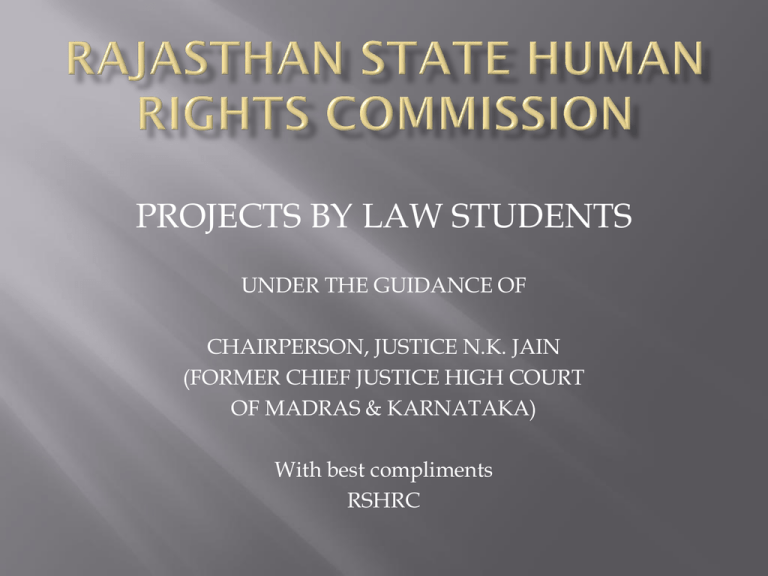
PROJECTS BY LAW STUDENTS
UNDER THE GUIDANCE OF
CHAIRPERSON, JUSTICE N.K. JAIN
(FORMER CHIEF JUSTICE HIGH COURT
OF MADRAS & KARNATAKA)
With best compliments
RSHRC
Under the guidance of
Hon’ble Mr. justice
N.K. jain
(former chief justice of
Madras & Karnataka
High Court)
Chairperson RSHRC
Prepared by:
Internship students of
various law universities
Hon’ble Chairperson and Members of
State Human Rights Commission are:
Justice N.K Jain, Chairperson
Members:
Justice Jagat Singh
Shri D.S.Meena
Shri Pukhraj Seervi
By:
Aarushi Bhargava
Birla Institute of Technology & Science
Msc. Biology, 2nd semester
aarushi142@gmail.com
Human trafficking as defined by the UN is, “the
recruitment, transportation, transfer, harbouring or
receipt of persons by means of the threat or use of force
or other forms of coercion, of abduction, of fraud, of
deception, of the abuse of power or of a position of
vulnerability or of the giving or receiving of payments
or benefits to achieve the consent of a person having
control over another person, for the purpose of
exploitation. Exploitation shall include, at a minimum,
the exploitation of the prostitution of others or other
forms of sexual exploitation, forced labour or service,
slavery or practices similar to slavery, servitude or the
removal of organs.”
India is a source, destination, and transit
country for men, women, and children
trafficked for the purposes of forced labor and
commercial sexual exploitation. Internal forced
labor may constitute India’s largest trafficking
problem; men, women, and children are held in
debt bondage and face forced labor working in
brick kilns, rice mills, agriculture, and
embroidery factories. While no comprehensive
study of forced and bonded labor has been
completed, NGOs estimate this problem affects
20 to 65 million Indians.
Women and girls are trafficked within the
country for the purposes of commercial sexual
exploitation and forced marriage especially in
those areas where the sex ratio is highly
skewed in favor of men. Children are subjected
to forced labor as factory workers, domestic
servants, beggars, and agriculture workers, and
have been used as armed combatants by some
terrorist and insurgent groups.
India is also a destination for women and girls
from Nepal and Bangladesh trafficked for the
purpose of commercial sexual exploitation. Nepali
children are also trafficked to India for forced labor
in circus shows. Indian women are trafficked to the
Middle East for commercial sexual exploitation. In
some cases, such workers are the victims of
fraudulent recruitment practices that lead them
directly into situations of forced labor, including
debt bondage.
In other cases, high debts incurred to pay
recruitment fees leave them vulnerable to
exploitation by unscrupulous employers in the
destination countries, where some are
subjected to conditions of involuntary
servitude, including non-payment of wages,
restrictions on movement, unlawful
withholding of passports, and physical or
sexual abuse.
India is listed in the Tier II list of the UN which
includes countries which have failed to combat human
trafficking.
The report also says that the numbers of persons
affected could be anywhere between 20 to 65 million.
According to some estimates, the estimated annual
turnover of human trafficking in India is around 20
billion rupees. What is distressing is that out of the
total number of persons affected by human trafficking,
as many as 80 per cent are women and 50 per cent are
children (all the persons below 18 years of age come in
the category of children).
The people who recruit or the recruiters are the
first in the chain –often called as the “dalals” – they
may be parents, neighbours, relatives or lovers or
people who have been trafficked before. The dalals
move to the “potential sites” for victims which
mostly are the poverty-stricken areas where there
has been no proper rehabilitation and then they
haunt the bus stops, railway stations, streets, etc.
The period they choose for trafficking depends on
if that place has suffered a drought or social or
political disasters recently, so that it would be
easier to lure in the already suffering victims.
The dalals use drugs, abduction, kidnapping,
persuasion or deception to bag the targets
SURVEY
India is viewed as the fourth most dangerous country in
the world for women because of its poor record on
human trafficking and the widespread practice of female
feticide, according to a poll of 213 people who work in the
field of gender rights.
The poll, which was conducted
by TrustLaw Women, a women’s
rights information service from
the Thomson Reuters
Foundation, asked people in
academia, journalism,
development and other fields
about their perceptions.
India was regarded by 13% as
one of the most dangerous
countries for women on cultural
and religious grounds, while
12% picked it as the most
dangerous due to human
trafficking and 7% of the people
polled said India was the most
dangerous nation for women on
health. About 8% picked India as
the country where women were
most likely to face nonsexual
violence and 4% said it was the
most dangerous nation for sexual
violence.
ARCHIVES
CHILDLINE - Toll Free Call 1098 - Night & Day
www.childlineindia.org.in/aboutus08.htm
[accessed 10 February 2011]
CHILDLINE reaches out to all children in need of
care and protection such as: street children, child
labourers, children who have been abused, child
victims of flesh trade, differently-abled children,
child addicts, children in conflict with the law,
children in institutions, mentally challenged
children, HIV/AIDs infected children, children
affected by conflict and disaster, child political
refugees, children whose families are in crises.
Delhi Govt. Started the toll free 'Youth Phone
service’ 1-800-11-6888
The Government of Delhi running the 'youth'
helpline named Yuva Phone line in Delhi. The
counsellors are available round the clock on toll
free no 1800116888. The helpline is specially
for students.
Website to track missing children launched
Anasuya Menon, The Hindu, Coimbatore, Feb 10, 2007
www.hindu.com/2007/02/10/stories/2007021013590100.htm
[accessed 10 February 2011]
Parents can post photograph of missing child on the website
Anyone who has lost their child can post a message on this
website and a search will be set in motion simultaneously in 40
cities in the country. Launched by Don Bosco National Forum for
Youth at Risk in association with UNICEF,
www.missingchildsearch.net will be closely watched and
monitored by child welfare organisations in all major cities in the
country and a search will be generated immediately. The Don
Bosco National Forum for Youth at Risk is a major partner of
Childline India Foundation and extends service to hundreds of
children who are victims of war, conflict, natural calamities,
sexual exploitation, trafficking and HIV/AIDS. They also take care
of street and working children
The Department of Labor’s 2004 Findings on the Worst Forms of Child
Labor
U.S. Dept of Labor Bureau of International Labor Affairs, 2005
www.dol.gov/ilab/media/reports/iclp/tda2004/india.htm
[accessed 10 February 2011]
INCIDENCE AND NATURE OF CHILD LABOR - Bonded or forced
child labor is a problem and exists in several industries. Recent reports
indicate that the practice exists in carpet manufacturing and silk weaving.
India is a source, destination, and transit country for trafficking of
children for the purposes of commercial sexual exploitation and other
forms of exploitive labor. Children are reported to be trafficked from
India to the Middle East and Western countries such as the United States
and Europe; into India from Bangladesh and Nepal; and through the
country to Pakistan and the Middle East. Mumbai, Calcutta and New
Delhi are major destination cities for young girls trafficked from Nepal
and Bangladesh for the purpose of commercial sexual exploitation.
Children are also trafficked within India for sexual exploitation and
forced or bonded labor. Organized crime and police corruption were
common factors that contributed to the overall situation of trafficking in
India. An August 2004 study by the government estimated that almost
half of the trafficked children interviewed were between the ages of 11 to
14 years.
Concluding Observations of the Committee on the Rights of the Child
(CRC)
UN Convention on the Rights of the Child, 26 February 2004
www1.umn.edu/humanrts/crc/india2004.html
[accessed 10 February 2011]
[74] The Committee welcomes the ratification of the South Asian
Association for Regional Cooperation (SAARC) Convention on
Preventing and Combating Trafficking in Women and Children for
Prostitution; the adoption of a plan of action to combat trafficking and
commercial sexual exploitation of women and children; the initiative to
undertake a study, inter alia, to collect data on the number of children
and women who become victims of sexual exploitation and trafficking;
and the Pilot Projects to Combat Trafficking of Children for Commercial
Sexual Exploitation in Destination and Source Areas, but remains
concerned that the Immoral Traffic Prevention Act, 1986 does not define
trafficking and limits its scope to sexual exploitation. In addition, the
Committee expresses its concern at the increasing number of child victims
of sexual exploitation, including prostitution and pornography. Concern
is also expressed at the insufficient programs for the physical and
psychological recovery and social reintegration of child victims of such
abuse and exploitation.
Testimony of Anita
Anita Sharma Bhattarai, Polaris Project Action Center -- Special Thanks to:
Protection Project
zh-cn.connect.facebook.com/note.php?note_id=149013918476023
[accessed 10 February 2011]
I felt very scared that evening and I refused to eat anything. I soon noticed that
many men were coming in and out of the house and I realized it was a brothel. I
began howling and shouting. I said that I wanted to leave. Renu Lama told me that
I was ignorant. She said that I did not just come easily and I could not go easily.
She said that I had been bought and I would have to work as a prostitute in order
to pay them back.
On the fourth day that I was in the brothel, my first client came to me. I refused to
have sex with him. He had already paid so he grabbed me and tried to rape me. I
fought him off. He had managed to get my clothes off but he was very frustrated
because I was resisting him so much. He stormed out and asked for his money
back. A couple of the brothel owners (voluntary prostitutes) came in and beat me.
When they were done, the same man came back in.
Some of my associates overheard the owners saying that they were also planning
to sell me to a brothel in Sarat because I was too much trouble. I decided that I
could not wait until the boy returned from Nepal. I had to try again to run away. I
asked some of the other girls to run with me, but they were too afraid. We had
been told that we would be killed if we tried to run away. But I had determined
that I would rather die than stay in the brothel. The other girls pooled their money
together and came up with two hundred rupees. In exchange for the 200 rupees, I
promised that if I made it out alive, I would get help for them.
Bangla aiding NE human trafficking
The Assam Tribune, Guwahati, March 27, 2009
www.assamtribune.com/scripts/details.asp?id=mar2809/at09
[accessed 10 February 2011]
he Director General of Assam Police GM Srivastava today stated that
neighbouring countries, especially Bangladesh, continue to fuel the
growth of human trafficking cases in the Northeast, particularly Assam.
“There have been many instances where we have seen that professional
human traffickers from Bangladesh after marrying a girl from a remote
area in the State elopes back home and after keeping her in the
neighbouring country for some time, finally sells her to brothels in metros
of India,” said Srivastava, adding that the number of duped girls, who are
being duped by this racket of human traffickers, is increasing in the State.
Attributing the rise of human trafficking cases in the region to poverty
and the simplicity of the people here, the Assam Police chief stressed on
the need for an attitudinal change amongst the people to wipe out the
menace from the society.
CBI goes after foster parents in child racket
K Praveen Kumar, Times News Network (The Times of India) TNN, Chennai,
May 14, 2008
timesofindia.indiatimes.com/Chennai/CBI_goes_after__foster_parents_in_ch
ild_racket/articleshow/3037980.cms
[accessed 10 February 2011]
The case had originated on the basis of complaints from parents about
missing children. One of them, the child of Kathiravel and Nagamani,
pavement-dwellers in Pulianthope, had been allegedly kidnapped and
sold to a Dutch couple. Similarly, the four-year-old child of Sylvia, a
woman from Otteri, was kidnapped from an auto and sold to a couple in
Australia. Another couple from the city had lost their one-and-a-half-year
old child, who was traced to the US.
The racket was busted in the city in the first week of May 2005 after the
Otteri police received specific information about kidnapping of children
in and around Otteri. The police team then started investigations and
arrested seven people identified as Varadharajan, Sheikh Dawood,
Navjeen, Sabeera, Manoharan, Salima and K.T. Dawood. They
subsequently traced the racket to an illegal adoption agency, Malaysian
Social Service, which had kidnapped street children and sold them to
foreigners after forging certificates. The case was subsequently
transferred to the Crime Branch. – htsc
Prostitution is killing childhood in northeast, says study
Maitreyee Boruah, Indo-Asian News Service IANS, Guwahati, May 31 2008
www.thaindian.com/newsportal/uncategorized/prostitution-is-killingchildhood-in-northeast-says-study_10054950.html
[accessed 10 February 2011]
All is not well with children in India's northeast. A study conducted by a
Guwahati-based NGO along with the police has revealed that a shocking
20 percent involved in prostitution in the region are aged between 11 and
17 years.
In addition, the report also states that most of the children are victims of
acute physical torture. "They are initially raped and flogged almost to
death to take up the profession," the report said. Almost half of the child
prostitutes were from Assam, followed by Meghalaya, Manipur, Tripura,
Nagaland, Mizoram and Arunachal Pradesh, said Sarma. Some of the
victims were also sold to brothels in Mumbai, Pune and Ahmedabad.
"We have reports that sheikhs from the Middle East are also buying
northeastern girls from these brothels. Also, trafficking gangs from
Southeast Asian countries are taking a keen interest in the girls because of
their Mongoloid features," Sarma said
CBI goes after foster parents in child racket
K Praveen Kumar, Times News Network (The Times of India) TNN, Chennai,
May 14, 2008
timesofindia.indiatimes.com/Chennai/CBI_goes_after__foster_parents_in_ch
ild_racket/art
leshow/3037980.cms
[accessed 10 February 2011]
The case had originated on the basis of complaints from parents about
missing children. One of them, the child of Kathiravel and Nagamani,
pavement-dwellers in Pulianthope, had been allegedly kidnapped and
sold to a Dutch couple. Similarly, the four-year-old child of Sylvia, a
woman from Otteri, was kidnapped from an auto and sold to a couple in
Australia. Another couple from the city had lost their one-and-a-half-year
old child, who was traced to the US.
The racket was busted in the city in the first week of May 2005 after the
Otteri police received specific information about kidnapping of children
in and around Otteri. The police team then started investigations and
arrested seven people identified as Varadharajan, Sheikh Dawood,
Navjeen, Sabeera, Manoharan, Salima and K.T. Dawood. They
subsequently traced the racket to an illegal adoption agency, Malaysian
Social Service, which had kidnapped street children and sold them to
foreigners after forging certificates. The case was subsequently
transferred to the Crime Branch. – htsc
Child trafficking could become rampant in state unless tackled
urgently, feels activist
KanglaOnline, Imphal, Apr 8, 2008
-- Source:
www.kanglaonline.com/index.php?template=headline&newsid=4169
5&typeid=1
www.antitraf.net/home.php?mode=more&id=29&lang=en
[accessed 10 February 2011]
Every year thousands are trafficked across India for a variety of
reasons including sexual exploitation, bonded labour, organ
transplantation, adoption, coerced marriage etc. Women and
children are particularly vulnerable to human trafficking and in
Manipur child trafficking appears to be a growing epidemic.
Though the number of cases are rising, the state government has
failed to take any measures Anee Mangsatabam, the chairman of
Child Welfare Committee told IFP.
Various NGOs and organisations of the state who are working to
prevent human trafficking in the state, have said that due to lack
of funds and other reasons they were unable to take any action
against the traffickers.
Assam human trafficking: A startling revelation!
Jogesh Doley, merinews.com, Apr 06, 2008
www.merinews.com/article/assam-human-trafficking-astartling-revelation/131876.shtml
[accessed 10 February 2011]
Every year thousands of tea tribe girls are lured by people
and taken to different parts of India, to work as slave and in
most of the cases they lands up in brothels. Those who are
forced into sex work, or who are vulnerable to sexual
exploitation as domestic labourers, are particularly at risk of
sexually transmitted infections, including HIV, and
unwanted pregnancy.
The plight of the women from this community has remained
unheard and unattended, since ages and they are have no
other options but to migrate and to follow the people who
lure them and assure them good jobs out side the state. htcp
Punjab girls' NRI dream turns nightmare
Vikram Chowdhary, NDTV, Chandigarh, March 26, 2008
www.ndtv.com/convergence/ndtv/story.aspx?id=NEWEN200
80045064&ch=3/26/2008%202:56:00%20PM
[accessed 10 February 2011]
Every year thousands of Punjabis fly to foreign lands for
employment and better future. But for some, this dream
turns sour as they are cheated by travel agents and given
false assurances.
It was the last thing her father, Gurdev Singh, expected to
hear. He had sold land and took loans to pay Rs eight lakh
to a travel agent for her job in London. But she ended up in
Ukraine where she was forced into prostitution.
"We ran away and sought help from a lady in Ukraine and
narrated my entire story and told her that my travel agent
took away my passport and travel documents. With her
help, I was able to contact my family," added Manjit Kaur.
The scourge of human trafficking in India
Sandhya Nigam, merinews.com, Mar 17, 2008
www.merinews.com/article/the-scourge-of-humantrafficking-in-india/131079.shtml
[accessed 10 February 2011]
When Mona was 13 years, her mother died and her father
remarried. The stepmother was uncomfortable with Mona
and wanted to send her away for some job, where she
would be able to look after herself. Along came a
”contractor” who arranged jobs for youngsters as domestic
help, etc. He paid a certain sum of money to the stepmother
and took Mona to a town far away. He got her a job in a
massage parlour as a ‘receptionist’. Even before Mona got to
know the work profile, she realized that she had been
trapped into sexual exploitation. She had become a sexual
slave to the ‘customers’ who frequented the place for fullbody massage.
'Dr Kidney' arrest exposes Indian organ traffic
Sandhya Srinivasan, Inter Press Service News Agency IPS,
Mumbai, Feb 22, 2008
www.atimes.com/atimes/South_Asia/JB22Df03.html
[accessed 10 February 2011]
The arrest of "Doctor Kidney" Amit Kumar for running a
sizeable racket in live kidneys has highlighted the role that
South Asia plays as the hub of an international trade in
human organs. A sophisticated but unregulated healthcare
industry, a "donor pool" of desperately poor people ready to
sell a kidney, and a corrupt monitoring system have
combined to create a special brand of "medical tourism" in
the region, especially in India and neighboring Pakistan.
Kumar is accused of luring poor laborers to his "hospital"
in the New Delhi suburb of Gurgaon with promises of job
offers or large sums of money. Typically, they were
promised 300,000 rupees (US$7,500) but paid only 30,000
($750) after the surgery, police said. He is alleged to have
conducted more than 500 transplants over an unspecified
period, charging up to $50,000 dollars for each operation.
Investigators say his patients came from Britain, the United
States, Turkey, Nepal, Dubai, Syria and Saudi Arabia.
Four child labourers freed
Times News Network (The Times of India) TNN, Nagpur, Feb
19, 2008
timesofindia.indiatimes.com/Nagpur/Four_child_labourers_fr
eed/articleshow/2793754.cms
[accessed 10 February 2011]
Saddam said, "Our parents face severe hardships in making
both ends meet due to abject poverty. Sagir took advantage
of this and one day he came to our house and offered to
'help' the family by ensuring education for us. Gaining our
parents' confidence and consent, Sagir brought us to
Nagpur." He added, "When we arrived in the city, Sagir
took us to his zari embroidery unit in Farooq Nagar, near
Teka Naka. He forced us to work in the embroidery unit.
We used to work right from 8 am to 2 am, and he (Sagir)
used to pay us a very meagre Rs 15 to Rs 20 per week."
West Bengals sex workers remarkable fight against HIV
Soma Mitra, ANI-News, Kolkata, Dec 30, 2007
www.thaindian.com/newsportal/india-news/west-bengalssex-workers-remarkable-fight-against-hiv_10010751.html
[accessed 10 February 2011]
To stop human trafficking in sex trade, a self-regulatory
board has been established by the sex workers. The board
works as a filter and it checks whether the new girl joining
the trade is an adult or a minor. This board also tries to find
out if any new girl joining the profession is under any
pressure to do so. This has been very successful way to
check human trafficking, police raids have also reduced
considerably, said Swapna Gayen, who too is a sex worker
in Sonagachi for over two decades.
Trading flesh, selling souls
Deccan Herald, December 8, 2007
www.deccanherald.com/Content/Dec82007/she2007120740003.asp
At one time this article had been archived and may possibly still be
accessible [here]
According to the United Nations Office on Drugs and Crime
(UNODC), between two to three million people are trafficked
annually in and out of India. Most disturbingly, a large number of
people, especially girls and women, from states such as Andhra
Pradesh, Bihar, Uttar Pradesh, West Bengal, Orissa and the northeastern region, are trafficked to the metros such as Delhi and
Mumbai.
People from these states are trafficked to work in brothels, dance
bars, pubs, restaurants, friendship clubs, massage parlours and for
domestic chores, says Dr P M Nair, a senior police official and coauthor of the National Human Rights Commission (NHRC) study
entitled 'Trafficking in Women and Children in India'.
Human trafficking burst in Chhattisgarh, 400 villagers
rescued
Press Trust of India PTI, Nov 16, 2007
www.dnaindia.com/india/report_human-traffickingburst-in-chhattisgarh-400-villagers-rescued_1133523
[accessed 10 February 2011]
Over 400 villagers from Mahasamund district have
been rescued by the Chhattisgarh government officials
when they were being transported outside the state, a
senior official said on Friday.
"All the villagers were put inside the containers which
did not have have sufficient ventilation or light and
were being transported like animals," she said.
Sarpanch held for human trafficking [PDF]
Express News Service India, 6 Oct 2007
www.nts-pd.org/admin/affix/1193046531.pdf
[accessed 11 February 2011]
[page 8] On a tipoff, Patnagarh police, led by DSP
(crime) N C Dandsena, rescued the 40 labourers
when they were being taken to a nearby railway
station to work in a brick kiln unit. Police said the
Sarpanch had given some money to the labourers
in advance and forced them to go to Hyderabad.
They were to work in the brick kiln for five
months.
PROTECTION
India’s efforts to protect victims of trafficking varies from state to
state, but remains inadequate in many places.Victims of bonded
labor are entitled to 10,000 rupees ($225) from the central
government for rehabilitation, but this program is
unevenly executed across the country. Governmant authorities do
not proactively identify and rescue bonded laborers, so few victims
receive this assistance. Although children trafficked for forced labor
may be housed in government shelters and are entitled to 20,000
rupees ($450), the quality of many of these homes remains poor and
the disbursement of rehabilitation funds is sporadic.
Some states provide services to victims of bonded labor, but Non
Governmental Organisatins provide the majority of protection
services to these victims. The central government does not provide
protection services to Indian victims trafficked abroad for forced
labor or commercial sexual exploitation. Indian diplomatic missions
in destination countries may offer temporary shelter to nationals
who have been trafficked; once repatriated, however, neither the
central government nor most state governments offer any medical,
psychological, legal, or reintegration assistance for these victims.
Section 8 of the ITPA permits the arrest of women in prostitution.
Although statistics on arrests under Section 8 are not kept, the
government and some NGOs report that, through sensitization
and training, police officers no longer use this provision of the
law; it is unclear whether arrests of women in prostitution under
Section 8 have actually decreased. Because most law enforcement
authorities lack formal procedures to identify trafficking victims
among women arrested for prostitution; some victims may be
arrested and punished for acts committed as a result of being
trafficked.
Some foreign victims trafficked to India are not subject to removal.
Those who are subject to removal are not offered legal alternatives
to removal to countries in which they may face hardship or
retribution. NGOs report that some Bangladeshi victims of
commercial sexual exploitation are pushed back across the border
without protection services. The government also does not
repatriate Nepali victims; NGOs primarily perform this function.
Many victims decline to testify against their traffickers due to the
length of proceedings and fear of retribution by traffickers.
The central government continued to give grants to NGOs for the
provision of services to sex trafficking victims with funding
available through its Swadhar Scheme and the recently developed
Ujjawala Scheme.
Ministry of Labor and Employment displays full-page
advertisements against child labor in national
newspapers at periodic intervals. The government has
also instituted pre-departure information sessions for
domestic workers migrating abroad on the risks of
exploitation. Most of the Indian workers pay huge
sums of money to agents who facilitate their
emigration outside the official channels and willingly
emigrate despite being aware of the conditions
prevailing in those destinations. This is because of the
fact that most of the destinations abroad pay better
sums of money. Therefore, a dream of better future
ahead often lures the people abroad and hence
trafficking cannot entirely be prevented. India has not
ratified the 2000 UN TIP Protocol.
Google
Wikipedia
Unicef
Books of RSHRC
It gives me great pleasure to express my gratitude
to all concerned in helping me complete my
project. I am very thankful to Rajasthan State
Human Rights Commission for giving me a
chance to do the internship here.
thank you


